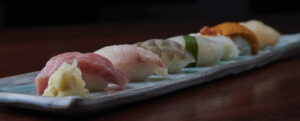At SUSHIYA, we love Japanese culture and first for this reason we run the Japanese restaurant sansaro in Munich.
Da unsere Gäste überwiegend natürlich Münchner oder München besuchende Touristen sind, sind viele unserer Arbeitsweisen und Umgangsformen im Restaurant auch an unsere lokalen Gepflogenheiten angepaßt. Hin und wieder lohnt sich aber ein Blick über den Tellerrand, und so hat uns eine anerkannte Japan-Expertin einen Artikel über einen Besuch in einem typischen Sushi-Restaurant in Japan geschrieben. Nicht alles trifft auf uns im sansaro zu — aber dennoch viel Spaß beim Lesen!
Encounter Japanese food culture
There are many rules and customs in Japanese food culture that should seem simple common sense even to a guest from abroad.
In addition, there are also some things that may seem a little strange at first glance. You probably already know some of the following rules or recommendations, but you will probably also find new and surprising things among them.
Let's just start right when you enter the restaurant. Often a loud, sometimes downright frightening "Irasshaimase"(Japanese for: "Welcome!") resounds towards you. The staff wants to show you that they are happy to welcome you as a guest and want to serve you with attention and enthusiasm.
Please wait to be seated!
In Japan, as in other countries, it is usually customary to wait at the reception until you are assigned a seat. Simply heading for a (seemingly) free seat is a bit rude.
In a Japanese restaurant, check in with the service staff when you visit, as if you were making a polite visit, rather than finding a table yourself right away.
If there are both tables and counter seats in a (sushi) restaurant, the latter are usually the more desirable seats and reserved for regular or special guests, because here the guest can watch the chef at work and also communicate. Every professional chef is happy when his work and tools are appreciated. So feel free to show your interest. And of course, in Japan, this is the real art of the sushi chef: to discreetly parley with the guest about the food or the day's events, holding back, but also guiding the guest.
Once you are seated, a hot (sometimes cold) oshibori is usually brought in Japan. These are either small shrink-wrapped paper towels for one-time use or small moistened terry cloth towels the size of a washcloth, which you roll up after the first wipe and leave next to you. In sushi restaurants in particular, they are used again and again during the meal, since sushi is often eaten with the bare hand. Of course, these wipes are not thrown away every time but collected again.
Recognize quality in sticks
In front of you, you will usually already find the chopsticks. Depending on the restaurant, these can be particularly decorative chopsticks or disposable wooden chopsticks (waribashi, 割り箸). These differ mainly in that they either hang together at the end and are only divided by the guest or are already single.
Sometimes you see the guest rubbing them together to supposedly remove splinters or smooth the surface. However, with this gesture you are implying that it is inferior quality and therefore they should avoid it. Strictly speaking, you are suggesting to the restaurant that it does not take good enough care of its guests....
Therefore, we do not know such a thing in good Japanese restaurants as a behavior of Japanese guests - but observe it in Western countries often with international guests, for whom this seems to be a kind of supposedly Asian ritual.
You should not rub the chopsticks to prepare food or let them rattle through your hands in a better Japanese restaurant.
By the way, there is then a special form of chopsticks, which is used almost only when serving Kaiseki are used. They are pointed at both ends and resemble an oversized grain of rice in shape. This is quite intentional. It is also said that one end belongs to the guest and the other ends to the deities.
In some top class restaurants, the chopsticks often arrive at the table already damp. This is not a mistake because they would still be damp from washing up, but it is to prevent the dry wood from soaking up the liquid and thus the taste of the first bites and thus distorting the taste of other dishes in the course of the rest of the meal. Since it may well happen that you are invited to such a restaurant by your hosts in Japan, it may make sense to keep this information in mind.
Omakase - leave it to the cook
Assuming that you have been given one of the coveted seats opposite the chef or at your favorite table, you can of course order your favorite sushi individually. But why not take the plunge and order omakase (お任せ)? Omakase means "I leave it to you!" in German, so to speak.
The chef will gradually serve you the sushi that he thinks are the best that day (or even his specialty). You don't have to be afraid that you'll get what has to go fast here, on the contrary you'll get the best the house has to offer. If there is an ingredient that you don't like at all, you can tell the team right at the beginning and they will surely take it into account.
The best order for sushi
With such an omakase, you will be able to observe what you should also take into account when you yourself are Sushi order individually: often there is a little at the beginning Sashimi, usually starting with a white fish and then perhaps later somewhat fattier varieties such as Chu-Toro (中とろ) or even O-Toro (大とろ), which melt in the mouth. More nigiri (握り) follow little by little, where the topping is again rather light at the beginning and then increases until, for example, a piece of grilled fish is also used.
Basically, you should eat sushi from the soft, delicate flavors to the more intense varieties. At the end, also like a "Tamago" (egg sting) as a conclusion.
Sushi, soy sauce and wasabi used correctly
There will be a small plate in front of you and you can put something there. Soy sauce fill in. Please not much, a few drops are enough! Sushi does not want to be drowned in soy sauce, but the taste is accentuated only very slightly. In the end, otherwise it will also be too salty...
With the sushi you may also get a little wasabi, even freshly grated in very expensive restaurants or on special occasions.
Bitte verrühren Sie nicht Wasabi in der Sojasauce – das macht man nur bei Sashimi.
Both - soy sauce and wasabi - are meant to be just a little icing on the cake, because the chef prepares each sushi in such a way that its ingredients and seasoning are perfectly matched and don't really need any additional seasoning.
Therefore, you should also be careful not to dip the rice of a sushi in the soy sauce but only the topping side of nigiri, maki briefly. The rice would get soaked and too much soy sauce would drown out all the flavor. In addition, the art of the sushi master is also to apply just enough pressure to the rice during preparation so that it holds together but does not become a compacted mass. And if such a slightly sticking together rice is then dipped into the soy sauce, it immediately falls apart.
Before you start eating, you may want to devoutly say "Itadakismasu" (頂きます). This is not a religious exercise, but means something like "Bon appétit" because the exact translation is "humbly I accept with thanks".
Pickled ginger is not a side salad
So little by little the various sushi come to you and you wonder what the gari (sour pickled ginger), which is ready from the start, is actually for. Not for seasoning, as you might think. No, it is to refresh or cleanse the palate between the various sushi. You can imagine it similar to a wine tasting, where you take some bread or water between the different wines to be able to taste the aromas of the next wine again with all its nuances. And it is precisely this task that the gari takes on in sushi.
Ingwer beim Sushi ist kein Beilagensalat und auch auf keinen Fall zusätzliches „Topping“ für Sushi — der Ingwer dient im Bedarfsfall der Geschmackserfrischung zwischen verschiedenen Sushi.
Bei Sashimi erfüllt ein fein geschnittener Rettich diese Funktion (bitte bestellen Sie kein Ingwer zum Sashimi!).
Sushi is also something special in Japan
Contrary to popular belief, sushi food in Germany is neither "Japanese fast food" nor "everyday cuisine". This misconception probably stems from the fact that there are assembly line eateries in Japan, in which the busy Japanese can also only eat quickly and that on the other hand Makimono (here especially the large futomaki) are not so much served in Japanese high-end restaurants, but are rather to be assigned to Japanese home cooking and bento cuisine. In high-end restaurants you will find mainly Nigirizushi.
For good sushi you should therefore take your time take and then when you enjoy so in peace, of course you want the appropriate drink to go with it. Of course, you can choose whatever you like, but you will only get to the full enjoyment if you stick to traditional drinks like green tea (Ocha, を茶) or Sake (酒) hold.
Paying attention to the community when drinking
And we are already at the next important recommendation.
Often Sake in tokkori (small bottle) placed on the table, and a pot of tea for refilling is also common. But whether you are drinking sake, beer or wine, if there is a bottle at the table and you are eating in company, it is considered extremely rude to top yourself up. Therefore, they should always keep an eye on the vessels of your table neighbors and top them up when the glass/cup is empty. You can be sure that you won't be shortchanged, because every Japanese is used to doing just that with their neighbor - and you are a neighbor, after all. This could go on indefinitely, so there's a small but unmistakable sign that you've had enough: you simply leave a sip in the glass. Then everyone knows you've had enough and you don't have to gratefully decline a refill.
End a meal by saying "Gochisōsama deshita" ("Thank you for the delicious meal," 御馳走様でした).
Then, of course, before you go home again after a delicious and pleasant meal, the bill must be settled. In some Japanese restaurants, a piece of paper listing all the sushi and drinks eaten is left at the table. You then take this and go to the cashier. In "finer" restaurants, you just go to the cashier and the attentive staff there already knows exactly which of the present bills belongs to which guest. Since it is generally unusual to tip in Japan, paying is then very simple: the amount on the bill is enough.
Paying separately is considered impolite in Japan
There are two more tips on this: If you are going out to dinner with friends/acquaintances and everyone plans to pay for themselves, Japanese people would usually not insist on individual bills but one person will do the paying in the restaurant and then afterwards (usually outside the restaurant) everyone will pay their share then, not counting up exactly who had what but simply dividing the total by the number of people eating. Anything else would be quite rude.
The second tip is for particularly good restaurants in Japan (e.g. Kappō or Kaiseki, i.e. traditional cuisine). Here, everything is planned, staged and directed as precisely as a play. Guests should not feel observed when paying, so they try to have only one guest at the cash register at a time. In addition, the O-Kami (something like hostess, often the wife of the owner) leads the guests to the door and waves until the guest is out of sight.
Typical for Japan: Show consideration
Begehen Sie also bitte nicht den Fehler in Sichtweite der winkenden Restaurantmitarbeiter stehen zu bleiben und sich noch zu unterhalten oder beispielsweise mit einer Begleitung die nächsten Schritte zu planen.
Ihre Gastgeberin, die O-Kami, wird sonst nicht wieder hinein gehen und dort ihren Pflichten nachkommen können. Gehen sie einfach um die nächste Ecke oder besteigen ein Taxi. Dann können Sie plaudern so lange Sie wollen.
In principle, however, you should refrain from paying separately in Japanese restaurants. It is very unusual and especially with sushi with the many small, individual components very rude, especially towards the other guests, if a table of 4 or 8 people the service staff long with the Ausfieseln of all the bills busy.
Japanese cuisine culture also expression of Japanese society
You see: other countries, other customs. Even from the German point of view, the Japanese may sometimes seem very stiff, very formalized. Surely this also differs from restaurant to restaurant and in the different circles, whether you are in a remote izakaya or a great sushi restaurant on the Ginza in Tōkyō.
But in general, in Japan, in all areas, you can observe that people first show more consideration for each other, take care not to disturb other guests, and appreciate the efforts of service and kitchen staff .
Keeping that in mind and fitting into the seemingly rigid corset of Japanese formality, one can indeed feel like royalty in Japan or in a Japanese restaurant, because then it is usually the staff's greatest pleasure to fulfill the guest's every wish.





